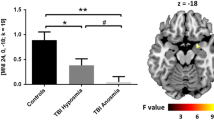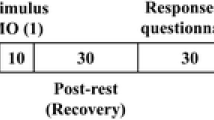Abstract
Magnetic resonance imaging (MRI) and chemosensory event-related potentials (ERPs) are important methods to evaluate olfactory function, but there is lack of study to explore the application of MRI and chemosensory ERPs in the patients with traumatic anosmia. The data of 26 post-traumatic anosmic patients and 21 healthy controls were retrospectively surveyed; olfaction and olfactory pathway of all participants were measured clinically using the T&T olfactometer, the Sniffin’ Sticks, chemosensory ERPs and MRI. All patients were anosmic based on complaints and clinical examinations. In five patients, the olfactory bulb volume was significantly lower than control group. In 18 patients, the olfactory sulcus (OS) depth was similar to control group, but all the participants had a deeper right OS (right = 7.79 ± 1.31, left = 7.06 ± 1.44, p < 0.01). Olfactory ERPs (oERPs) could be evoked in 17 patients, but these signals showed longer latencies and lower amplitude than controls in the N1 (latency p < 0.05, amplitude p < 0.01) and P2 (latency p < 0.01, amplitude p < 0.05) waves. Nine traumatic anosmic patients had no identifiable oERPs; most of them had olfactory center injury. Trigeminal ERPs were detected in all anosmic patients and controls; patients had longer latencies for N1 (p < 0.05) and P2 (p < 0.05) waves, while there was no similar change in amplitude. Older subjects had smaller OB volume and OS depth. Closed head injury could induce anosmia; the severity extent, injury site and subsequent consciousness are related to the olfaction. oERP is the gold standard for olfactory subjective examination; MRI could indicate the lesions on the olfactory pathway and reflect the possibility of detectable oERPs.


Similar content being viewed by others
References
Temmel AF, Quint C, Schickinger-Fischer B et al (2002) Characteristics of olfactory disorders in relation to major causes of olfactory loss. Arch Otolaryngol Head Neck Surg 128:635–641
Haxel BR, Grant L, Mackay-Sim A (2008) Olfactory dysfunction after head injury. J Head Trauma Rehabil 23:407–413
Yousem DM, Geckle RJ, Bilker WB et al (1996) Posttraumatic olfactory dysfunction: MR and clinical evaluation. AJNR Am J Neuroradiol 17:1171–1179
Hawkes CH, Shephard BC, Daniel SE (1997) Olfactory dysfunction in Parkinson’s disease. J Neurol Neurosurg Psychiatry 62:436–446
Hawkes CH, Shephard BC, Kobal G (1997) Assessment of olfaction in multiple sclerosis: evidence of dysfunction by olfactory evoked response and identification tests. J Neurol Neurosurg Psychiatry 63:145–151
Goektas O, Fleiner F, Sedlmaier B et al (2009) Correlation of olfactory dysfunction of different etiologies in MRI and comparison with subjective and objective olfactometer. Eur J Radiol 71:469–473
Rombaux P, Weitz H, Mouraux A et al (2006) Olfactory function assessed with orthonasal and retronasal testing, olfactory bulb volume, and chemosensory event-related potentials. Arch Otolaryngol Head Neck Surg 132:1346–1351
Rombaux P, Huart C, Deggouj N et al (2012) Prognostic value of olfactory bulb volume measurement for recovery in postinfectious and posttraumatic olfactory loss. Otolaryngol Head Neck Surg 147:1136–1141
Yang L, Wei Y, Zhang W et al (2012) Examination of chemosensory functions in patients with dysosmia. Med Sci Monit 18:CR154–CR159
Atighechi S, Salari H, Baradarantar MH et al (2009) A comparative study of brain perfusion single-photon emission computed tomography and magnetic resonance imaging in patients with post-traumatic anosmia. Am J Rhinol Allergy 23:409–412
Eftekhari M, Assadi M, Kazemi M et al (2006) Brain perfusion single photon emission computed tomography findings in patients with posttraumatic anosmia and comparison with radiological imaging. Am J Rhinol 20:577–581
Yang L, Wei Y, Yu D et al (2010) Olfactory and gustatory function in healthy adult Chinese subjects. Otolaryngol Head Neck Surg 143:554–560
Ishimaru T, Shimada T, Miwa T et al (2002) Electrically stimulated olfactory evoked potential in olfactory disturbance. Ann Otol Rhinol Laryngol 111:518–522
Kobal G, Klimek L, Wolfensberger M et al (2000) Multicenter investigation of 1,036 subjects using a standardized method for the assessment of olfactory function combining tests of odor identification, odor discrimination, and olfactory thresholds. Eur Arch Otorhinolaryngol 257:205–211
Rombaux P, Potier H, Markessis E et al (2010) Olfactory bulb volume and depth of olfactory sulcus in patients with idiopathic olfactory loss. Eur Arch Otorhinolaryngol 267:1551–1556
Duprez TP, Rombaux P (2010) Imaging the olfactory tract (cranial nerve #1). Eur J Radiol 74:288–298
Ren Y, Yang L, Guo Y et al (2012) Intranasal trigeminal chemosensitivity in patients with postviral and posttraumatic olfactory dysfunction. Acta Otolaryngol 132:974–980
Hummel T, Bensafi M, Nikolaus J et al (2007) Olfactory function in children assessed with psychophysical and electrophysiological techniques. Behav Brain Res 180:133–138
Swann IJ, Bauza-Rodriguez B, Currans R et al (2006) The significance of post-traumatic amnesia as a risk factor in the development of olfactory dysfunction following head injury. Emerg Med J 23:618–621
de Kruijk JR, Leffers P, Menheere PP et al (2003) Olfactory function after mild traumatic brain injury. Brain Inj 17:73–78
Hummel T, Damm M, Vent J et al (2003) Depth of olfactory sulcus and olfactory function. Brain Res 975:85–89
Huart C, Meusel T, Gerber J et al (2011) The depth of the olfactory sulcus is an indicator of congenital anosmia. AJNR Am J Neuroradiol 32:1911–1914
Mandairon N, Linster C (2009) Odor perception and olfactory bulb plasticity in adult mammals. J Neurophysiol 101:2204–2209
Wilson DA, Best AR, Sullivan RM (2004) Plasticity in the olfactory system: lessons for the neurobiology of memory. Neuroscientist 10:513–524
Rombaux P, Mouraux A, Bertrand B et al (2007) Can we smell without an olfactory bulb? Am J Rhinol 21:548–550
Kern RC, Quinn B, Rosseau G et al (2000) Post-traumatic olfactory dysfunction. Laryngoscope 110:2106–2109
Jiang RS, Chai JW, Chen WH et al (2009) Olfactory bulb volume in Taiwanese patients with posttraumatic anosmia. Am J Rhinol Allergy 23:582–584
Hummel T, Smitka M, Puschmann S et al (2011) Correlation between olfactory bulb volume and olfactory function in children and adolescents. Exp Brain Res 214:285–291
Yousem DM, Geckle RJ, Bilker WB et al (1998) Olfactory bulb and tract and temporal lobe volumes. Normative data across decades. Ann N Y Acad Sci 855:546–555
Buschhüter D, Smitka M, Puschmann S et al (2008) Correlation between olfactory bulb volume and olfactory function. Neuroimage 42:498–502
Fitzek S, Fitzek C, Huonker R et al (2004) Event-related fMRI with painful electrical stimulation of the trigeminal nerve. Magn Reson Imaging 22:205–209
Kettenmann B, Hummel C, Stefan H et al (1997) Multiple olfactory activity in the human neocortex identified by magnetic source imaging. Chem Senses 22:493–502
Lötsch J, Hummel T (2006) The clinical significance of electrophysiological measures of olfactory function. Behav Brain Res 170:78–83
Li W, Lopez L, Osher J et al (2010) Right orbitofrontal cortex mediates conscious olfactory perception. Psychol Sci 21:1454–1463
Seubert J, Freiherr J, Frasnelli J et al (2013) Orbitofrontal cortex and olfactory bulb volume predict distinct aspects of olfactory performance in healthy subjects. Cereb Cortex 23:2448–2456
Acknowledgments
The study was supported by National Natural Science Foundation of China (NSFC) under the project No. 81271062 and Capital Application Research of Clinical Specialty under the project No. Z121107001012041. We thank Dr. Jayant M. Pinto from Section of Otolaryngology–Head and Neck Surgery, the University of Chicago Medicine and Biological Sciences for reviewing the manuscript. The authors have no conflict of interest regarding this study.
Author information
Authors and Affiliations
Corresponding author
Rights and permissions
About this article
Cite this article
Miao, X., Yang, L., Gu, H. et al. Evaluation of post-traumatic anosmia with MRI and chemosensory ERPs. Eur Arch Otorhinolaryngol 272, 1945–1953 (2015). https://doi.org/10.1007/s00405-014-3278-x
Received:
Accepted:
Published:
Issue Date:
DOI: https://doi.org/10.1007/s00405-014-3278-x




